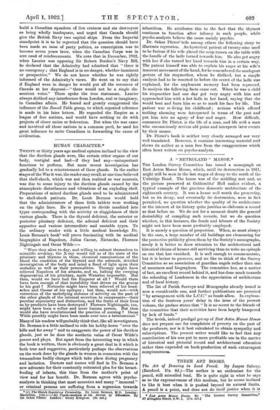THREE ART BOOBS.
The Art of Drawing in Lead Pencil. By Jasper Salway. (Batsford. ICs. 6d.)—The author is an enthusiast for the pencil, still miscalled lead. He is quite right in what ho says as to the expressiveness of this medium, but he seems inclined to like it best when it is pushed beyond its natural limits. A pencil is a point, and does not do itself justice when it is • Bad Acton Manor House. By '" The London Survey Ootomittce: 27 Abingdon Street, S.W.1. [21a. net.'
made to imitate a brush and produCe the effects .cif washes. The authors of too many of the illustrations in this book seem to have tried to make• their drawings look like photographs. For this reason one turns with pleasure to such really beautiful work as Mr. Muirhead Bone's sketch of the dome of St. Peter's.
Drawing for Art Students and Illustrators. By Allen W. Seaby. (Batsford. 12s.)—In a book the aim of which is to help in the teaching of drawing, we naturally look first at the illustrations ; in the present case not so much at the repro- ductions of well-known things, such as the Holbein drawings at Windsor, but at such drawings from the living model as will be made by the student-reader of the book. These am not inspiring ; they have too much of the air of that deadening tradition of materialistic French studios. Such drawings as these, with their tame, smudged modelling, make the two drawings by Alfred Stevens a stimulating delight, with their living surface worked with a point. The master of this kind of critical drawing was, of course, Michelangelo, and it is perhaps significant that he is represented here only by a (hawing, obviously not authentic, of a flabby and feeble sort. If we turn to the letterpress of the book we find much that is interesting and helpful, especially the chapter on convention, which treats of the individual ways in which different artists work, having their own special end in view. --Greek Vase Painting. By Ernst Buschor. Translated by G. C. Richards. (Chatto and Windus. 25s.)—This is a learned work to go to for information and not for inspiration. It is essentially " museum " in its painstaking outlook and endless tracing of influences and styles. Consequently, much more space is given to the things which are interesting archaeologically than to those whose artistic qualities are more valuable. The illustrations are numerous. The difficulties of photographing drawings on the curved surfaces of vases account for so many of the reproductions being of copies rather than of the originals. When it has been possible to give the photograph of the original, the difference in the vitality of the drawing is most marked.



































 Previous page
Previous page